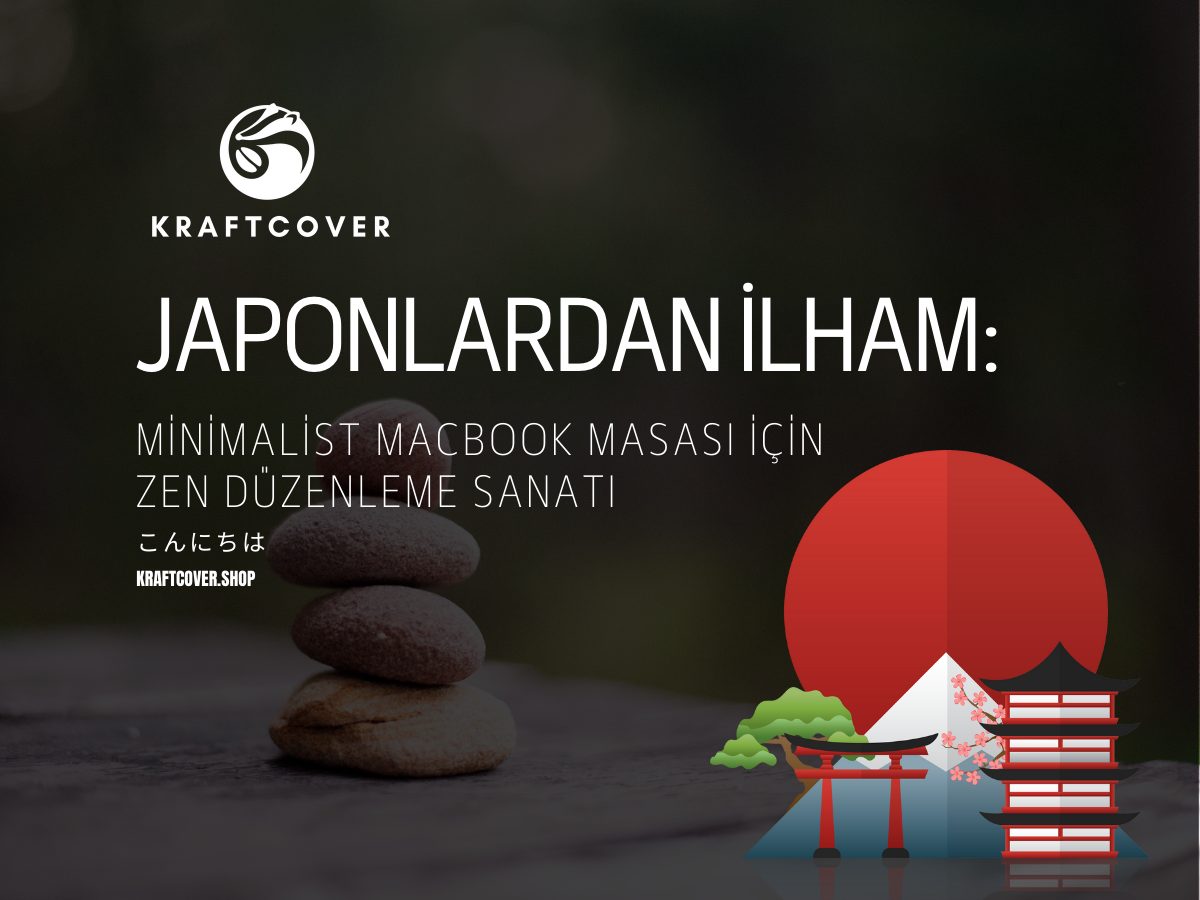こんにちは (Konnichiwa) dijital samuraylar! Bugün MacBook masanızı bir Zen bahçesine dönüştürmenin yollarını konuşacağız. Marie Kondo'nun "Bu sevinç veriyor mu?" sorusunu, "Bu kablo gerçekten gerekli mi?" sorusuyla değiştirmeye hazır mısınız? Hem Japon Zen felsefesini, hem de KraftCover’ın şık ve minimalist ürünleriyle çalışma alanınızı nasıl dönüştürebileceğinizi keşfedeceğiz.
MacBook Masasında Zen Felsefesi

Japon Zen felsefesi, sadelik ve dinginlik arayışını temel alır. Çalışma alanınızda bu felsefeyi uygulamak, sadece fiziksel değil, zihinsel bir düzen oluşturmanızı sağlar. Shizen yani doğallık, masanızı doğal malzemelerle sadeleştirirken, Seijaku (huzur) sessizlik ve düzenle odaklanmanızı kolaylaştırır. Bu, hem içsel hem dışsal uyumu sağlar.
"Ma" (間) Prensibi: Boşluğun Gücü
Japon estetiğinde "Ma", boşluğun gücünü temsil eder. Boşluk sadece fiziksel bir alan değil, aynı zamanda zihinsel bir durumu da ifade eder. Masanızda fazladan eşyalardan arındığınızda, hem daha rahat nefes alırsınız, hem de işinize daha iyi odaklanırsınız.
Boş Alan = Zihin Rahatlığı:
- Masada sadece MacBook
- Bir fincan yeşil çay
- Masa matı ile şıklık ve sadelik
Ve... başka bir şey yok!
(Evet, o 5 farklı şarj kablosu gidecek!)
Bu felsefe, çalışma alanınızda sadeleştirmeye önem verirken, aynı zamanda dikkatinizin sadece en önemli şeylere yönelmesini sağlar. KraftCover’ın sade ve zarif masa pedleri ile bu boşlukları estetik bir şekilde doldurabilirsiniz.
"Wabi-Sabi" (侘寂): Mükemmel Kusursuzluk
Wabi-sabi, Japon estetiğinin, kusurlu olanın da güzel olabileceği düşüncesine dayanan bir parçasıdır. Kablolarınız biraz dağınık olabilir, ama onları doğru yönlendirirseniz ve minimalist bir yaklaşım uygularsanız, bu düzen bir sanat eserine dönüşür.
Kablo Yönetimi Sanatı:
- Tek bir şarj kablosu (cesaretiniz varsa!)
- Kablosuz mouse/klavye
- KraftCover’ın kablo düzenleyicisi ve laptop standı (Kablo karmaşası artık eski bir Edo dönemi efsanesi!)
Kablo yönetimi, yalnızca estetik için değil, aynı zamanda üretkenlik için de önemlidir. Kabloların masada yayılmasını önlemek, zihinsel düzeninizi korumanıza yardımcı olur.
Minimalist MacBook Setup'ı
Minimalist bir MacBook setup'ı, Japon felsefesinin Kanso (sadelik) ve Seijaku (huzur) ilkeleriyle mükemmel bir uyum içindedir. Masanızda sadece gerekli öğeleri bulundurarak, görsel karmaşadan kurtulup, zihinsel sakinlik elde edersiniz. Doğal malzemelerden yapılmış sade aksesuarlar ve düzenleyiciler, iş verimliliğinizi artırırken aynı zamanda Zen prensiplerine dayalı huzurlu bir ortam yaratır.
1. "Kanso" (簡素) İlkesi: Sadelik
Kanso, sadeliğin güzelliğini ifade eden bir ilkedir. Masanızda sadece ihtiyacınız olan ürünleri bulundurarak, minimalist bir düzenle hem rahat hem de verimli bir çalışma alanı yaratabilirsiniz.
Temel Ekipman:
- MacBook için bambu stand
- Kablosuz Magic Keyboard
- Magic Trackpad
- KraftCover’ın doğal malzemelerden üretilmiş, minimalist masa pedi
Masanızın tek organik öğesi olan bonsainiz size doğanın sadeliğini hatırlatacak.
2. "Seijaku" (静寂) Düzeni: Huzurlu Sessizlik
Seijaku, sakinlik ve huzurun gücüdür. Masanızda sadece görsel sadelik değil, aynı zamanda sessizliği de hedeflemelisiniz. Gürültü kirliliğini azaltarak, huzurlu bir çalışma ortamı yaratabilirsiniz.
Sessiz bir çalışma ortamı, zihnin daha fazla odaklanmasına yardımcı olur. KraftCover’ın masa pedleri gibi yumuşak dokulu ürünler, hem sesin emilmesine yardımcı olur hem de sakin bir çalışma alanı sunar.
Zen Masa Düzeni: Adım Adım

1. "Danshari" (断捨離) Metodu: Eleme Sanatı
Danshari, gereksiz olan her şeyden kurtulmak anlamına gelir. Çalışma masanızdaki fazlalıklardan kurtulmak sadece fiziksel değil, aynı zamanda zihinsel bir rahatlık sağlar. KraftCover’ın düzenleyici ürünleri bu konuda büyük yardımcınız olabilir.
Masadan Atılacaklar:
- Kullanılmayan donglelar
- Eski Apple kutuları (evet, onlar da!)
- Post-it yığınları
- Duygusal bağınız olan ama kullanmadığınız her şey
Eleme sanatını uygulayarak sadeleşmiş bir masa yaratmak, işlerinize daha rahat odaklanmanızı sağlar. KraftCover 5 Girişli HUB ile masanızı hem düzenli hem de estetik tutabilirsiniz.
2. "Fukinsei" (不均整) İlkesi: Asimetrik Denge
Japon estetiğinde mükemmellik, denge ile değil, asimetri ile yakalanır. Bu yüzden çalışma alanınızda her şeyin mükemmel hizalı olması gerekmiyor. Bazen küçük bir kayma, dengeyi bozmadan estetik bir bütünlük yaratır.
Yerleşim Düzeni:
- MacBook sola hizalı
- Boş alan sağda
- Aksesuarlar tek bir köşede (Mükemmel asimetri için Apple logosunu kullanın)
Japon İlhamlı Masa Aksesuarları
Elbette, aksesuar seçenekleri arasında bambular yer alıyor. Bambu kutular veya bambu kalemlikler, Japon ilhamlı masa aksesuarları için ideal seçeneklerdir.
Zen Bahçesi:
Stresli günlerde küçük bir Zen bahçesi, zihninizi temizlemek ve huzurlu hissetmenizi sağlamak için harika bir dekoratif unsurdur. Minimalist bir takvim ya da bonsai gibi doğal unsurlar da Japon estetiğini vurgular.
Renk ve Materyal Seçimi
- "Shizen" (自然) Doğallık
Zen felsefesinde doğallık, her şeyin temelinde yatar. Masanızda doğal renkler ve materyaller kullanarak, sakin ve huzurlu bir atmosfer yaratabilirsiniz.
Renkler:
- Bej
- Gri
- Beyaz
- Materyaller
Plastikten uzak durarak bambu, ham ahşap ve doğal taş gibi malzemelere yönelmek, hem doğayla uyumlu bir çalışma alanı yaratmanızı sağlar hem de zihinsel dinginliği destekler.
Günlük Masa Bakım Ritüeli
Günlük masa bakım ritüeli, Japon felsefesindeki Kizen (sürekli iyileştirme) ilkesini yansıtır. Her gün masa düzeninizi koruyarak, hem fiziksel hem de zihinsel alanınızı yenileyebilirsiniz. Sabahları masayı düzenleyip sadeleştirmek, güne taze bir başlangıç yapmanıza yardımcı olurken, akşamları çalışma alanınızı toparlamak, ertesi güne hazır ve huzurlu bir zihinle başlamanızı sağlar.
Sabah Rutini
Her sabah çalışma alanınızı hazırlarken, sadeleşmiş bir masa düzeni ile günü karşılamak için küçük bir bakım rutini oluşturabilirsiniz.
- MacBook'u yerleştir
- Tek kabloyu bağla
- Bonsaiyi sula
- Masayı sil
- Meditasyon yap (veya mailleri kontrol et)
Akşam Düzeni
Her şeyi toparlayarak masanızı sade bir şekilde bırakmak, ertesi gün daha rahat çalışmanızı sağlar.
Minimalist Masa Psikolojisi
1. "Kizen" (起禅) Farkındalık
Masa düzeniniz, zihninizin bir yansımasıdır. Daha az eşya ile çalışmak, daha az stres ve daha fazla verimlilik anlamına gelir.
Az eşya = Az stres
Temiz masa = Temiz zihin
Düzenli alan = Verimli çalışma
2. Dijital Minimalizm
Sadece fiziksel değil, dijital alanda da sadeleşmeye gidin. Masaüstünüzde az dosya ve düzenli uygulamalar ile dijital minimalizmi de hayatınıza katın.
MacBook için Dijital Minimalizm içeriğimizi inceleyin!



